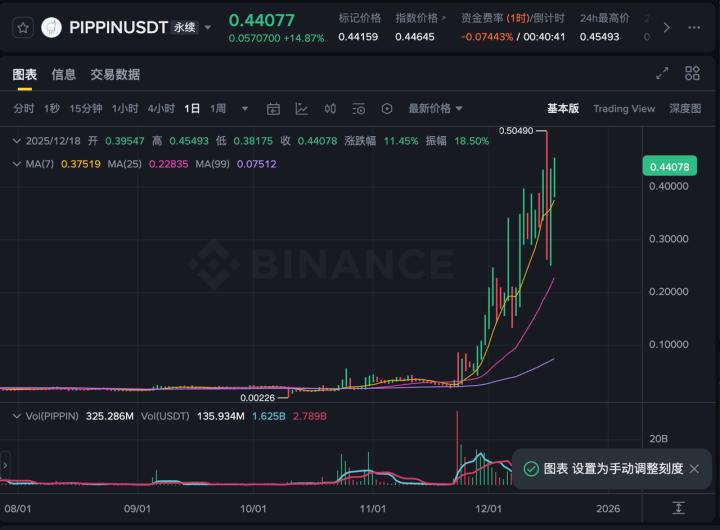
Article source: Words Beyond Words
According to the research report by The Kobeissi Letter, the current long-term inflation expectation in the United States has soared to 4.1%, reaching its highest level since 1993. Trump's tariff policy is considered the main cause of this issue, as there has been a trade deficit of over $300 billion in just over two months, which severely affects consumer confidence. In addition to long-term inflation expectations, the 1-year inflation expectation has also surged from 2.6% to 5.0%, essentially doubling in less than three months, which will inevitably create a relatively negative emotional impact on the investment market. As shown in the chart below.

Under these circumstances, the decline of US stocks is not difficult to understand, and the crypto market will experience an even larger drop, while gold continues to rise and break historical highs. It seems that smart big money is making choices through practical actions. In just over two months, the inflow of gold ETFs has reached $12 billion. As shown in the chart below. This year, the S&P 500 has dropped nearly 5%, while gold prices have risen nearly 17%, which seems to reveal an atmosphere of economic slowdown.

Let's return to the crypto market.
BTC, which has been touted as digital gold in recent years, does not seem to exhibit gold-like properties. BTC's price has dropped 30% this year, causing many people to be bearish on the crypto market and believing there is no hope left.
However, looking at BTC's current situation, it seems to be better than any period in history, as it has transformed from a so-called tulip bubble to a national strategic reserve asset in the United States. More and more large institutions are beginning to adopt BTC, which means BTC's image is slowly undergoing qualitative changes.
In the medium and short term, BTC still cannot become true gold (digital gold attribute). Compared to gold, it cannot serve as a mature hedging tool for big money, and its price is still subject to huge fluctuations caused by speculative factors. Currently, BTC looks more like a tech stock. However, in the long term, we believe BTC will eventually become a global asset and exist as an effective financial instrument on various balance sheets, which seems to be just a matter of time.
But for this cycle, although theoretically a new bull market seems to have started in 2023 (2023-2025), if we look at some indicator experiences, it appears that we have not yet experienced the so-called theoretical big bull market (or crazy bull market), as shown in the chart below.

There might be two possibilities:
One is that the crypto market no longer follows historical cycle indicators and rules.
Two is that the crypto market has not yet truly ushered in the theoretical big bull market.
Which of these two situations do you personally lean towards?
We do not provide a specific answer here, as this question has no standard answer. Different people may have different perspectives.
In recent articles by Words Beyond Words, we have mentioned Trump quite frequently because his every move currently has a direct impact on market trends.
Last year, Trump's friendly crypto promises led to BTC breaking the $100,000 historical mark, while this year, his tariff policies have caused continuous BTC pullbacks. The US BTC strategic reserve, which was highly anticipated, has merely become an asset composed of confiscated funds.
On one hand, Trump's policies after taking office have caused the market to plummet, and on the other hand, the WLFI (World Liberty Financial, Trump family project) investment portfolio continues to accumulate crypto assets (including ETH), and they recently announced plans to launch a new USD stablecoin called USD1, creating a rather strange and interesting phenomenon.

In the current overall market environment, the crypto market's catalyst seems to rely more on external environmental factors (given insufficient internal innovation), meaning if the market wants to rise again, it mainly hopes for 3 points:
First, Trump's tariff policies end within a few months.
Second, the Federal Reserve adopts a new Quantitative Easing (QE) policy to stimulate the market (providing more liquidity conditions, causing some liquidity to overflow into the crypto market).
Third, global net liquidity continues to increase (although the US dollar remains king, increased net liquidity from the EU, China, and Japan will to some extent promote price increases of high-risk assets like BTC).
However, these major points currently do not seem very clear, and the market may need more time to wait and digest.
Here, we might make a single-angle assumption (note this is just an assumption). If we look at the Global M2 indicator from a macro perspective, this indicator has existed with a BTC trend lag of about 70 days. For example, on September 23, 2024, Global M2 reaches a stage peak of $108 trillion, and on December 17, 2024, BTC reaches a stage peak of $108,000.
Therefore, theoretically: if Global M2 reaches a stage peak of $109 trillion on March 24, 2025, then without any new major black swan events, BTC might rebound to a stage high point in June 2025 (just a stage high point, not necessarily breaking the historical high).

Of course, you can directly reject the above assumption. Since it is an assumption, it may be right or wrong. There is no need to continue arguing. We are merely providing a possible perspective and not offering any investment guidance.
Currently, there are many opinions and voices online. I have also occasionally been paying attention to the remarks and sentiments of KOLs on CT (Crypto Twitter), and found that:
Most KOLs seem to be bearish and claim to have precisely exited at the high points, which I admire.
Some KOLs believe the big bull market hasn't started yet, and $100,000 BTC is merely a new starting point, with BTC prices potentially breaking new highs and reaching $150,000 by year-end.
Some also believe a new round of price increases might occur in the second quarter of this year... and so on.
However, everyone's thoughts or views differ, and the corresponding strategies will vary. What others say or do is not important; what's important is what you will do? Do you have different coping strategies?
Personally, although I sold 10% of my BTC in December last year, I am still in an active BTC accumulation state and am "enjoying" profit pullbacks again. Fortunately, I have experienced such situations many times, and the current market sentiment has not brought me any new anxiety.
Because funds are always flowing, financial markets will never lack hot topics. I noticed that recently many people seem to be studying gold, US stocks, and Hong Kong stocks again, but I have not participated in these. Apart from not having that much time and energy, I will continue to stay focused in the crypto field and keep improving myself.
This morning, I also saw a piece of text shared by a partner in the group, which also resonates with my current state of mind:

Tomorrow (April 2) is the special day that Trump has been hinting at recently. This president may announce reciprocal tariffs averaging over 15% on imported products from about 25 countries. Additionally, some important economic data will be released by the US this week, so we may continue to see significant market volatility. If you don't know what to do at this time, the best approach is to do nothing.
Due to Trump's potential reciprocal tariff measures, Goldman Sachs has significantly raised US inflation expectations and lowered GDP growth forecasts. Meanwhile, Goldman Sachs predicts that the Federal Reserve will cut rates three consecutive times in 2025 (in July, September, and November), ultimately maintaining the federal funds rate forecast at 3.50–3.75%.
Although some institutions like Goldman Sachs have issued new expectation reports, the high inflation expectations and rate cut expectations undoubtedly add more new uncertainties to the market.
Let's look at another data point: currently, the average US tariff rate has reached around 8%, which is the highest level since 1970. If the US tariff war continues to escalate this week, we might see a new round of retaliatory policies from some countries, potentially evolving into a global large-scale trade war. In other words, this month (April), we might witness the US average tariff rate breaking the 1946 record. As shown in the image below.

For Trump, who likes to stir things up, tariff wars alone seem insufficient. He has recently been conducting other provocative operations, such as publicly stating yesterday (March 30) that Iran would be bombed if they do not reach an agreement with the US. As shown in the image below.

Tariff wars + military threats seem to be Trump's current specialty, and these events will impact not just the crypto market and stock market, but also global economy and situation to a certain extent.
Today (April 1) is April Fools' Day, tomorrow is the "US Liberation Day" in Trump's words (April 2 was called Liberation Day by the US president), and for the market's overall trend this April, is it a new beginning? Or a new end?
Let's leave this to time to tell us the answer.
As ordinary investors, we seemingly cannot change the big picture, and the only thing we can change is our own position (protect our position and patiently wait for new money-making opportunities).







